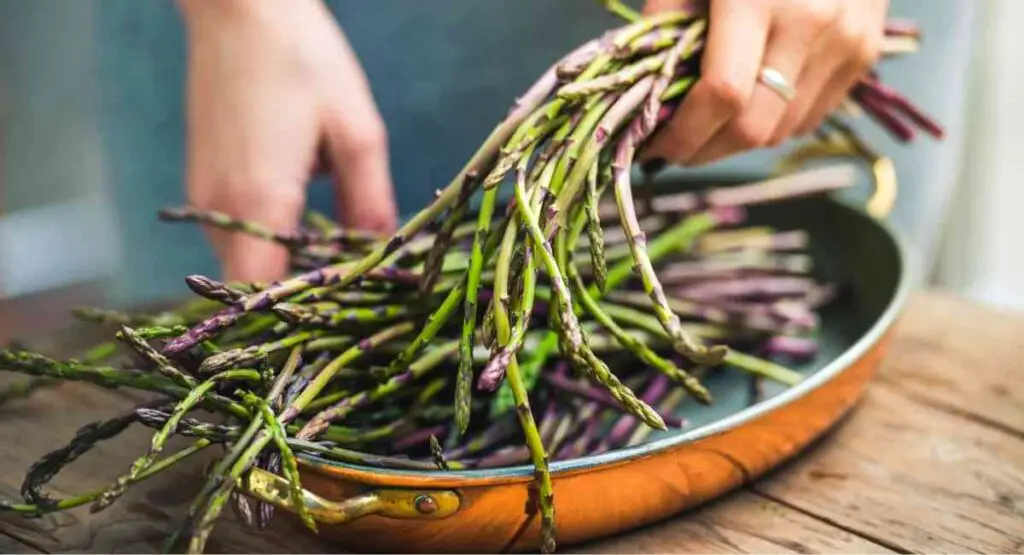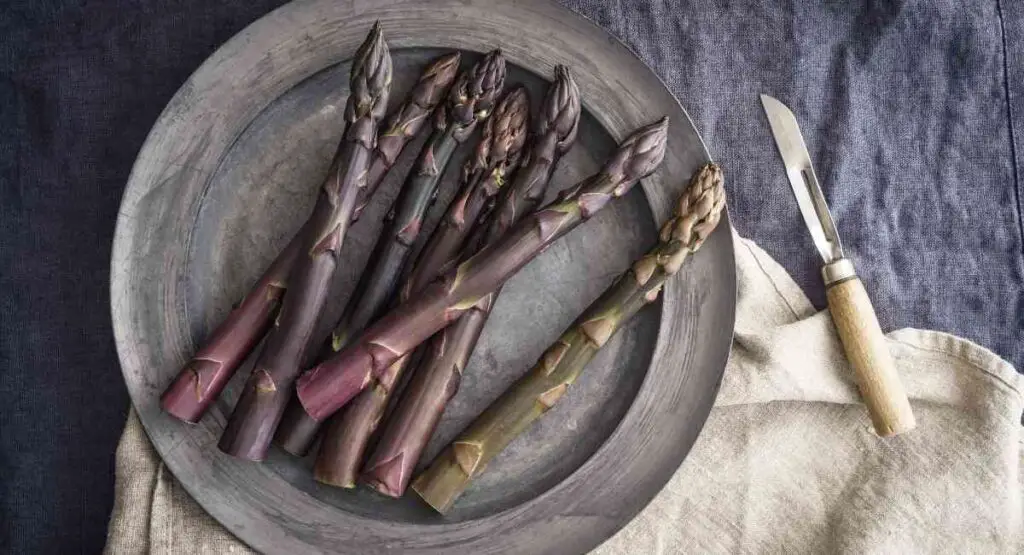Purple asparagus is a delicious, sophisticated, and versatile vegetable. It’s slightly different from its more well-known counterparts, green asparagus and white asparagus. Purple asparagus offers a lot of health benefits.
It is a multifaceted vegetable and can be used in many healthy recipes. So, if you stumbled upon purple asparagus on your recent grocery shopping or farmer’s market trip and are wondering how to cook purple asparagus, don’t worry. We have you covered!
This article will help you understand purple asparagus and how it differs from its other family members, and how you can create tasty dishes with it. This includes blanching, roasting, and sautéing.
As a bonus, we will also be sharing two yummy recipes that you can make while using your asparagus spears to their full potential! Read on to find out more.
What Is Purple Asparagus, and How Does It Differ from Other Varieties?
Purple asparagus is one of three varieties of asparagus from the Asparagaceae family. These colored vegetables are mostly grown and cultivated in parts of China, North America, South America, and Europe.
They are suitable for the open field as well as protected culture cultivation. They tend to be cultivated in early spring, and their bright color will put anyone into a festive mood. Asparagus is a delight for vegetarians and is a staple in dishes during the vegetarian spring.
However, Purple asparagus was developed only in Italy as a local variety in a city called Albenga. It was first named “Violetto d’ Albenga” for selling purposes, which means “The Violet (Asparagus) of Albenga,” and goes to show that the deep violet hue of the legume was much appreciated and loved. In addition, its spears are pretty large, so portioning is not a problem.
The thing about purple asparagus is quite different from its green and white counterparts in several ways. Firstly, it has a considerably higher sugar content (about 20% more) and lower dietary fiber.
However, this delicious vegetable is simply sweeter and more tender than other kinds of asparagus when cooked. It is also very buttery, creamy, and nutty in flavor, making it a sophisticated vegetable more suitable for an adult palate.
Finally, something that gives purple asparagus its unique color is a compound known as anthocyanin. This compound also makes asparagus of the purple variety highly high in antioxidants.
Increasing your intake of anthocyanins has reduced the risk of heart attacks, heart disease, and hypertension. This makes this vegetable a great addition to your daily diet!

Should You Peel Purple Asparagus?
Before starting your cooking adventures with this beautiful asparagus, you might be wondering if you need to peel it. The answer is that it is not necessary.
Purple asparagus is generally tender and less fibrous than green or white asparagus, so it’s less chewy. If anything, blanching, boiling, or cooking makes it even more tender and delicious. If you’re dealing with a very thick spear of asparagus, you should peel it to make it more digestible. Otherwise, thin and medium asparagus spears do not need peeling.
Fun fact: peeling your purple asparagus may reveal green layers inside! Not to worry, though. People prefer to eat it raw or cook it minimally – to maintain that gorgeous color.

How to Cook Purple Asparagus
Let’s look at some of the ideal ways to cook purple asparagus. For this, prepping your asparagus properly is very important. First, cut the ends of the thicker stalks of the asparagus (the few inches at the bottom), and set them aside. Don’t discard them! We’ll show you a way to use them, so keep reading.
Then, you should rinse them well under running water, and finally, peel them with a vegetable peeler if you must.
The authentic Italian way would be to steam this vegetable. Steaming is a great way to preserve the color and the texture and smell of purple asparagus varieties.
Steam them for around 5-10 minutes, add a dash of olive oil, and season with salt. So there you have it: a simple but ingenious asparagus side dish. For this, simplicity is vital.
Another way to cook purple asparagus is to boil them. Take a pot with high walls and fill it halfway with water. Once the water comes to a boil, place the asparagus inside and cover it with a lid. Leave the tips of your veggies out of the liquid and allow them to cook with the steam.
This will ensure a nicely cooked, tender, soft, and nutty asparagus. You may also blanch your asparagus. Blanching and boiling are a bit different. In blanching, you will do the same steps as in boiling but will put the asparagus into a bowl of ice-cold water to shock them into stopping the cooking process.
Roasting purple asparagus is always a great idea. Roasting creates a delicious char on your beautiful legumes, adding a nice color and flavor contrast to the bright, buttery, and floral notes.
But roasting must be done after a quick parboil to ensure proper cook-through. Parboil your asparagus for around 5 minutes, and then spread them out on a baking tray. If you’re feeling fancy, you can sprinkle your spears with extra virgin olive oil, salt, and parmesan cheese!
Of course, we must talk about true simplicity: eating them raw! An advantage of purple asparagus is that it’s so tender it can be eaten raw. So cut the top purple parts into thin strips, sprinkle them with flaky salt, fresh lemon juice, and olive oil, and enjoy!
To cook asparagus and make a good dish out of it, though, we recommend pairing it with eggs (boiled, fried, poached), fish that has been steamed, or some delicious sauces that offset the nuttiness of the asparagus.
Finally, remember how we told you earlier not to throw out or discard the ends of your asparagus stalks after cutting them? You can use them in so many versatile ways, one of which is to boil them for around 10 minutes or until they are tender.
After that, you should blend them up while adding oil slowly to form an emulsion. Season it however you wish, and you have a delicious asparagus-based sauce that will leave your guests wowed! You can use this sauce/cream in portions of pasta as a base to make risottos, and you can even spread it on classic bruschetta!
Two Simple but Delicious Purple Asparagus Recipes for Beginners
Here are two quick and easy recipes for those of you who are cooking with purple asparagus for the first time:
Purple Asparagus with Garlic Herb Butter
“Purple Asparagus with Garlic Herb Butter” is a deliciously simple dish. Take a large frying pan and set your stove to medium-low heat. Put three tablespoons of butter in the pan to melt, and add two minced garlic cloves. You will know when it’s done once it becomes fragrant and your kitchen smells lovely.
After that, you can add around one bunch of asparagus spears (cut into two-inch pieces) with the stalks removed. Sauté these until they have reached your preferred level of tenderness. This is the part where you may add a sprinkle of fresh parsley for some freshness and color.
This will offset the violet hues in this simple side dish with some green. Finally, season well with salt and black pepper, and the dish is done.
Asparagus Salad
The second recipe is a delicious asparagus salad. All you need to do is combine two pounds of purple asparagus (cut into 1.5-inch pieces) with the following ingredients. These include a three-fourths cup of toasted pine nuts, a quarter cup each of mint leaves and basil leaves, and one cup of chopped red onion.
To season this salad, make a dressing out of two tablespoons of lemon juice, one tablespoon of Dijon mustard, and three tablespoons of olive oil. You should also add salt and pepper to your liking.
The end product will be an easy, hearty salad that is equal parts healthy and yummy and will keep you coming back for more.
Bottom Line
Incorporating purple asparagus into your diet is a surefire way to keep yourself fit and healthy! It packs a lot of punch.
Our article has shown you how to cook purple asparagus in as many ways possible. This includes boiling, steaming, roasting, baking, blanching, and even eating it raw.
To enjoy this vegetable to its full potential, one must use the simplest possible ingredients for the highest quality outcome. So the next time you’re hanging out at your nearest farmer’s market, don’t forget to pick up the purple asparagus.

